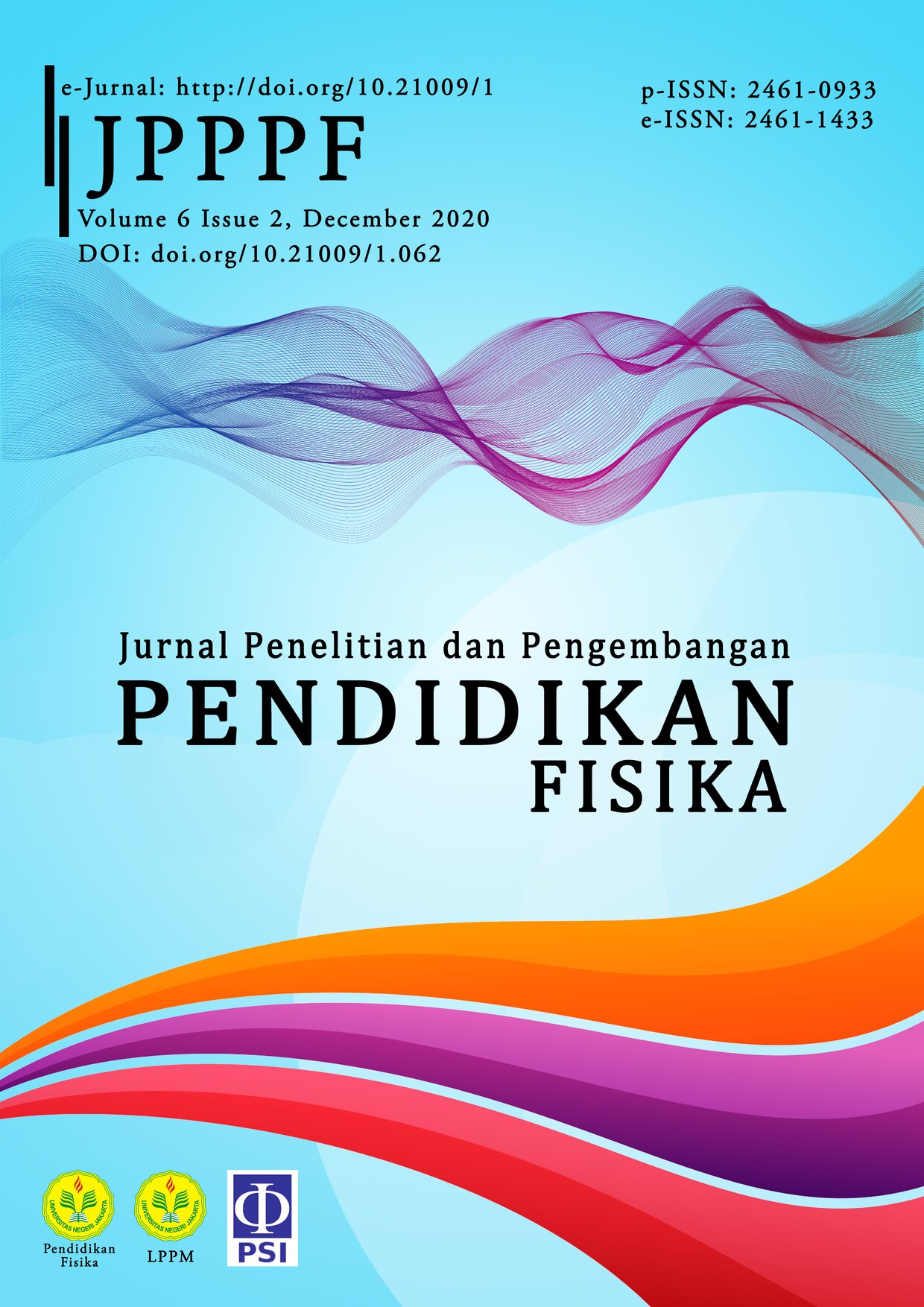Development of Electronic Module Using Creative Problem-Solving Model Equipped with HOTS Problems on The Kinetic Theory of Gases Material
DOI:
https://doi.org/10.21009/1.06205Keywords:
e-module, creative problem solving, HOTS, kinetic theory of gasesAbstract
This research aims to develop and produce an e-module of physics using a creative problem-solving model equipped with HOTS problems on the kinetic theory of gases material as independent teaching material for high school students of class XI IPA. The research method used in this study is the Research and Development (R & D) method using the model of Dick & Carey. The creative problem-solving model has six learning stages. The electronic module is equipped with HOTS questions, where HOTS is a high- level thinking skill that includes three indicators, including analyzing skills (C4), evaluating (C5), and creating (C6). The instrument used in this study is a questionnaire using a Likert scale. This e-module has gone through a validation test involving material experts, media experts, and learning experts. The results of expert validation are 82.83%. The result in the field-test by physics teachers shows an average score of 83.05%. The field-test results by the students of SMAN 16 Jakarta shows an average score of 93.44%. The result of the effectiveness test had a gain score of 0.502 indicates that the e-module can increase students’ high order thinking skills in the middle classification. These results show that the e-module of physics using a creative problem-solving model equipped with HOTS questions in the kinetic theory of gases material can be feasible as independent teaching material and can increase students’ high order thinking skills.
References
Arsyad, A 2007, ‘Media Pembelajaran’, Jakarta: PT. RajaGrafindo Persada.
Bakri, F, Siahaan, BZ, & Permana, AH 2015, ‘Rancangan Website Pembelajaran Terintegrasi dengan Modul Digital Fisika Menggunakan 3D PageFlip Professional’, Jurnal Penelitian & Pengembangan Pendidikan Fisika, vol. 2, no. 2, pp. 113-118.
Depdiknas 2003, ‘Undang-undang RI Nomor 20 Tahun 2003 Tentang Sistem Pendidikan Nasional,
Dick, W, & Carey, L 2015, ‘The Systematic Design of Instructional’, New Jersey: Pearson Education.
Hake, RR 1999, ‘Analyzing Change/Gain Scores’, AERA-D, American Educational Research Association’s Division D, Measurement and Reasearch Methodology.
Hansson, L, Hansson, Ö, Juter, K, & Redfors, A 2015, ‘Reality–Theoretical Models–Mathematics: A Ternary Perspective on Physics Lessons in Upper-Secondary School’ Sci & Educ, vol. 24, pp. 615–644.
Hansson, L, Hansson, Ö, Juter, K, & Redfors, A 2020, ‘Curriculum Emphases, Mathematics and Teaching Practices: Swedish Upper-Secondary Physics Teachers’ Views’, Int J of Sci and Math Educ.
Keiler, LS 2018, ‘Teachers’ roles and identities in student-centered classrooms’, International Journal of STEM Education, vol. 5, Article number: 34.
Meiarti, D & Ellianawati, E 2019, ‘Mind Mapping Based Creative Problem Solving: Train The Creative Thinking Skills of Vocational School Students in Physics Learning’, Jurnal Penelitian & Pengembangan Pendidikan Fisika, vol. 5, no. 2, pp. 91-100.
Muliyati, D, Bakri, F, & Ambarwulan, D 2018, ‘Aplikasi Android Modul Digital Fisika Berbasis Discovery Learning’, Jurnal Wahana Pendidikan Fisika, vol. 3, no.1, pp. 74-79.
Muslikh 2013, Peraturan Menteri Pendidikan Pendidikan dan Kebudayaan Republik Indonesia Nomor 69 Tahun 2013 Tentang Kerangka Dasar dan Struktur Kurikulum Sekolah Menengah Atas/Madrasah Aliyah, Jakarta: Kemdikbud.
Pratiwi, WT 2013, ‘Pengaruh Penerapan Creative Problem Solving (CPS) Terhadap Kemampuan Berpikir Kritis Siswa pada Mata Pelajaran Fisika Kelas XI IPA MAN 3 Malang’, sl, sn.
Rahmawati, A, Nisfah, NL, Kusairi, S 2019, ‘The Capability Analysis of High Order Thinking Skills (HOTS) on Dynamic Electricity Material in Junior High School’, Jurnal Penelitian & Pengembangan Pendidikan Fisika, vol. 5, no. 2, pp. 163-168.
Sousa, F, Monteiro, I, Walton, A, & Pissarra, J 2013, ‘.Learning from Failure: A Case Study on Creative Problem Solving’, Procedia - Social and Behavioral Sciences, vol. 75, pp. 570–580.
Sundayana, R 2014, ‘Statistika Penelitian Pendidikan’, Bandung: Alfabeta.
Tomkin, JH, Beilstein, SO, Morphew, JW, & Herman, GL 2019, ‘Evidence that communities of practice are associated with active learning in large STEM lectures’, International Journal of STEM Education, vol. 6, article number: 1.
Turşucu, S, Spandaw, J, & de Vries, MJ 2020, ‘Search for Symbol Sense Behavior: Students in Upper Secondary Education Solving Algebraic Physics Problems’, Res Sci Educ, vol. 50.
Widana, IW 2017, ‘Modul Penyusunan Soal HOTS’, Jakarta: Kementerian Pendidikan dan Kebudayaan.
Wiemer M 2019, ‘Learning through Research: Independent Learning. Self-Learning Processes and Self-Learning Abilities in Inquiry-Based Learning’, Inquiry-Based Learning – Undergraduate Research, pp. 29-36.











